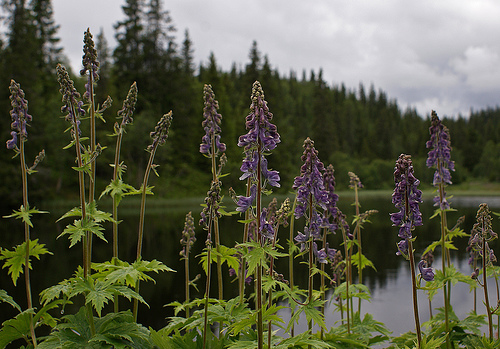Don’t let wolfsbane be the bane of your life!
- Wolfsbane is a genus of highly toxic perennial plants, found in the mountainous regions across Asia, Europe and North America.
- The scientific name of the wolfsbane is Aconitum and it is from the family Ranunculaceae, the family of buttercups.
- ‘Wolfsbane’ is also known as ‘monkshood’, ‘aconite’, ‘blue rocket’, ‘devil’s helmet’ and ‘women’s bane’, among others; and it is said to have been used as a method of killing troublesome wolves, hence one of the plant’s common names.
- Wolfsbane typically grows to be a height of 0.6 to 1.2 metres (2 to 4 feet), and it is often used ornamentally in the garden, especially towards the back of a garden bed.
- The blooms of wolfsbane are grouped along tall stems, and they are generally a blue or purple colour, though they can also be pink, yellow or white.
Wolfsbane
Image courtesy of Randi Hausken/Flickr
- Wolfsbane flowers are similar in appearance to a monk’s hood, and what appears to be five petals, are actually sepals.
- Wolfsbane consists of pseudaconitine, a toxin that is very poisonous, and a person (or animal) can be poisoned by consuming any part of the plant, though touching the plant may also be hazardous, especially if one has open cuts or abrasions.
- Wolfsbane poisoning can cause vomiting or nausea early on, leading to a burning feeling, weakness and numbness, and it usually affects the heart, often causing death within a short time-frame if left untreated.
- Sunny locations are preferred by wolfsbane plants, although they can still survive in shade, and they grow from tubers; or new plants can be started from seed.
- The toxic attribute of wolfsbane plants has not been neglected throughout history, as it has been used for both hunting, particularly for poison arrows, and assassination.
Bibliography:
Aconitum, 2016, Wikipedia, https://en.wikipedia.org/wiki/Aconitum
Buchan U, How to Grow: Monkshood, 2015, The Telegraph, http://www.telegraph.co.uk/gardening/11215801/How-to-grow-Monkshood.html
Rhoades J, Aconitum Monkshood: What is the Best Way to Grow Monkshood in the Garden, Gardening Know How, http://www.gardeningknowhow.com/ornamenta l/flowers/monkshood/growing-monkshood-plants.htm







Um my daughter had to do this project about Wolfs Bane Plant and what she really did like were the facts there were really interesting to her. And basically, her teacher asked on where did you get the website or something and I was like here go!